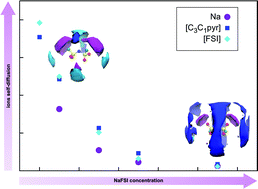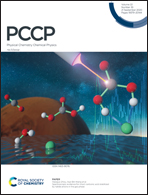Sodium diffusion in ionic liquid-based electrolytes for Na-ion batteries: the effect of polarizable force fields†
Abstract
Understanding the transport of sodium ions in ionic liquids is key to designing novel electrolyte materials for sodium-ion batteries. In this work, we combine molecular dynamics simulation and experiments to study how molecular interactions and local ordering affect relevant physico-chemical properties. Ionic transport and local solvation environments are investigated in electrolytes composed of sodium bis(fluorosulfonyl)imide, (Na[FSI]), in N,N-methylpropylpyrrolidinium bis(fluorosulfonyl)imide, [C3C1pyr][FSI], at different salt concentrations. The electrolyte systems are modelled by means of molecular dynamic simulations using a polarizable force field. We show that including polarization effects explicitly in the molecular simulations is required in order to attain a reliable description of the transport properties of sodium in the [C3C1pyr][FSI] electrolyte. The validation of the computational results upon comparison with experimental data allows us to assess the suitability of polarizable force fields in describing and interpreting the structure and dynamics of the sodium salt–ionic liquid system, which is essential to enable the application of IL-based electrolytes in novel energy-storage technologies.



 Please wait while we load your content...
Please wait while we load your content...